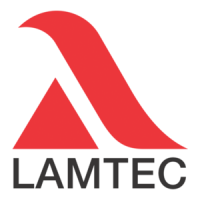
Do you have a question about the Lamtec MCC and is the answer not in the manual?
| Manufacturer | Lamtec |
|---|---|
| Type | MCC |
| Protection Class | IP20 |
| Communication Protocol | Modbus RTU |
| Category | Control Systems |
| Relative Humidity | non-condensing |
Explains the symbols used in the document for safety information and the operator's responsibilities.
Defines the target audience for the instructions and the prerequisite for safe operation.
Highlights specific safety instructions to avoid personal injury and damage to property and the environment.
Provides guidelines for safe installation and mounting of the CMS and its components.
Details essential safety precautions and requirements for electrical installation wiring.
Lists critical safety checks and documentation requirements during the commissioning phase.
Ensures proper operation of electronic ratio control by setting adequate excess air and monitoring actuators.
Lists essential checks required before commissioning the basic device for proper functioning.
Highlights checks for correct setting of time parameters and valve leakage control functions.
Explains the software's processing of flame tolerance time and its calculation for response time.
Specifies requirements for approved flame sensors and guidelines for electrical connection and signal transmission.
Details checks for device label information, safety parameters, and functional tests for proper operation.
Outlines insulation requirements for third-party devices connected to the CMS communication interface.
Explains basic burner sequencing functionality with process diagrams for different fuel types.
Illustrates the default process sequence chart for gas modulating burners with a pilot burner.
Illustrates the default process sequence chart for gas modulating burners without a pilot burner.
Illustrates the default process sequence chart for oil modulating burners with a pilot burner.
Illustrates the default process sequence chart for oil modulating burners without a pilot burner.
Describes the 'Start Without Pre-Purge' function, requiring fail-safe external signal and specific configuration.
Describes the standby mode functionality, including requirements, inputs/outputs, and parameters.
Details the 'Purging After Operation' function, including valve activation and timing sequences.
Describes pilot burner continuous operation where the pilot valve remains open after the safety time.
Details the valve leakage test procedure, including requirements, parameters, and flow charts.
Describes the electronic ratio control system, requirements, parameters, and commissioning.
Explains the burner firing rate controller, including requirements, inputs/outputs, and parameters.
Guides on setting passwords and inputting parameters, referencing relevant chapters.
Mentions checklists for final commissioning checks and system tests.
Describes accessing the CMS menu for programming ratio controller setpoint curves.
Explains programming RC curves with setpoint graphic and curve table views in configuration mode.
Explains how to configure special points for valve/damper opening/closing at specific times using CMS remote software.
Describes configuring range limits (RL.U, RL.L) for actuators using the CMS remote software.
Explains the necessity of checking actuator shut-off limits and conditions for omitting this check.
Details how to check shut-off limits using CMS remote software, using arrow keys for adjustment.
Ensures stable burner burning at O2 monitoring shut-off limits and checks correction influence.
Guides on displaying burner faults, including fault codes, diagnostic codes, and operating hours.
Details how to set the duration for pre-purge and post-purge periods and valve leakage test.
Details setting servomotor curve sets, including firing rate points and feedback adjustments.
Explains adjusting PID controller settings and CO/O2 controller settings like mode and correction mask.
Describes accessing burner firing-rate controller information and settings via the CMS interface.
Describes accessing CO/O2 optimisation information and settings via the CMS interface.
Explains dataset operations like opening, saving, comparing, and exiting the application.
Explains setting passwords, changing passwords, and customer codes for different access levels.
Guides on accessing and changing parameter values, noting access level restrictions and greyed-out parameters.
Details parameters for firing rate control, including configuration, PID terms, and reset requirements.
Guides on accessing O2 trim parameters, noting access level restrictions and reset requirements.
Details the process of updating CMS firmware, including connecting PC, preparing, and flashing.
Considers factors for set-point values, actuators, and parameters for correctional intervention.
Explains how the CO controller maintains combustion by outputting correction signals to actuators.
Describes searching for optimum working points by dynamically modifying fuel-air mixture and plausibility analysis.
Explains manual and automatic fault resetting procedures for the CMS and LT3-F.
Provides guidelines for commissioning CO/O2 controller, including checks and parameter settings.
Describes commissioning electronic ratio control and O2 measurement, and the effect of incorrect settings.
Explains setting correction range and spread factor for air actuator, detailing parameters and factory settings.
Ensures stable burner burning at O2 monitoring shut-off limits and testing correction effect.
Ensures safe and stable burner operation at maximum correctional intervention and firing rate ranges.
Guides on setting and optimizing the CO response threshold on LT3-F for CO regulation.
Details the process of commissioning the CO/O2 control, including fault resetting.
Guides on configuring, setting, evaluating, and monitoring CO and O2 trim using CMS Remote Software.
Explains automatic and manual fault restarts, ensuring compliance with safety requirements.
Details the process of updating CMS firmware, including connecting PC, preparing, and flashing.
Describes maintenance tasks, including repeating system tests after parameter changes or software updates.
Provides instructions for decommissioning systems according to EN 61508, including planning and safety analysis.